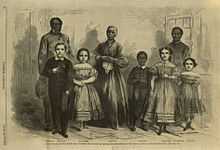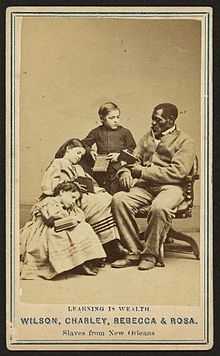White slave propaganda

White slave propaganda refers to the use of images of former slaves during the American Civil War to elicit sympathy from northern whites. The images themselves consisted of Caucasian-looking children being photographed alongside African American men, of which both groups were former slaves, in attempt to show them as being white. In turn, the hope was that northern whites would purchase the photographs of the children and help to fund education of former slaves in liberated parts of Louisiana.
Background

In December 1863, a large portion of the state of Louisiana was controlled under the Union Army. In this region, ninety-five schools, containing 9,500 students were being run. Due to the strain of the war, funding would need to be procured to continue to run the schools. As a result, the National Freedman's Association, in collaboration with the American Missionary Association and sympathizing Union officers launched a campaign where five children and three adults, all of whom were former slaves were sent to the north on a publicity campaign. A woodcut of them was commissioned and appeared in the Harper's Weekly in January 1864 with the caption "EMANCIPATED SLAVES, WHITE AND COLORED."[1]
Tour
Eight persons were transported from New Orleans to the North. Of these, four children appeared to be white. According to the Harper's Weekly article, they were, "'perfectly white;' 'very fair;' 'of unmixed white race.' Their light complexions contrasted sharply with those of the three adults, Wilson, Mary, and Robert; and that of the fifth child, Isaac—'a black boy of eight years; but nonetheless intelligent than his whiter companions.'"[1][2][3]
The group was accompanied by colonel from the 18th Infantry Regiment, and posed for photos at the Metropolitan Museum of Art in New York City and in Philadelphia. The resulting images were produced in the format of Carte de visite, and were sold for a quarter each, with the profits of the sale being directed to Major General Nathaniel P. Banks back in Louisiana. On each of the photos, it was explained that the proceeds from the sale would be, "...devoted to the education of colored people..."[1][2]
Legacy
Of the many prints that were commissioned, at least twenty-two remain in existence today. Most of these were produced by Charles Paxson and Myron Kimball, who took the group photo that later appeared in Harper's Weekly. A portrait of Rebecca, taken by James E. McClees of Philadelphia also is existent.[1]
Modern analysis

Modern scholars have recently begun investigating the causes of the White slave campaign's success. Mary Niall Mitchell in "Rosebloom and Pure White, Or So It Seemed," has argued that because the slaves were depicted as being white through both their skin color and style of dress, this meant that the argument could be made that the war was independent of class status, something which was needed after the draft riots in New York City that year. Carol Goodman in "Visualizing the Color Line," has argued that the photos stemmed from allusions of physical abuse, an argument which is strengthened when paired with the comments of the editor of the Harper's Weekly article when they said, that it permits slave-holding, "'gentlemen' [to] seduce the most friendless and defenseless of women." Gwendolyn DuBois Shaw, in "Portraits of a People," has argued that the usage of props such as the American flag and books helps to not only make the photo relateable to Northern whites, but also show that the purpose of the photos are for education and the raising money for schools in Louisiana.[1]
References
| Wikimedia Commons has media related to White slave propaganda. |
- ↑ 1.0 1.1 1.2 1.3 1.4 Caust-Ellenbogen, Celia. "White Slaves". Bryn Mawr College. Retrieved 11 July 2013.
- ↑ 2.0 2.1 "'White' slave children of New Orleans". New York Daily News. 21 September 2012. Retrieved 31 August 2013.
- ↑ "The 'white' slave children of New Orleans: Images of pale mixed-race slaves used to drum up sympathy among wealthy donors in 1860s". 27 February 2012 (London: Daily Mail). 28 February 2012. Retrieved 31 August 2013.